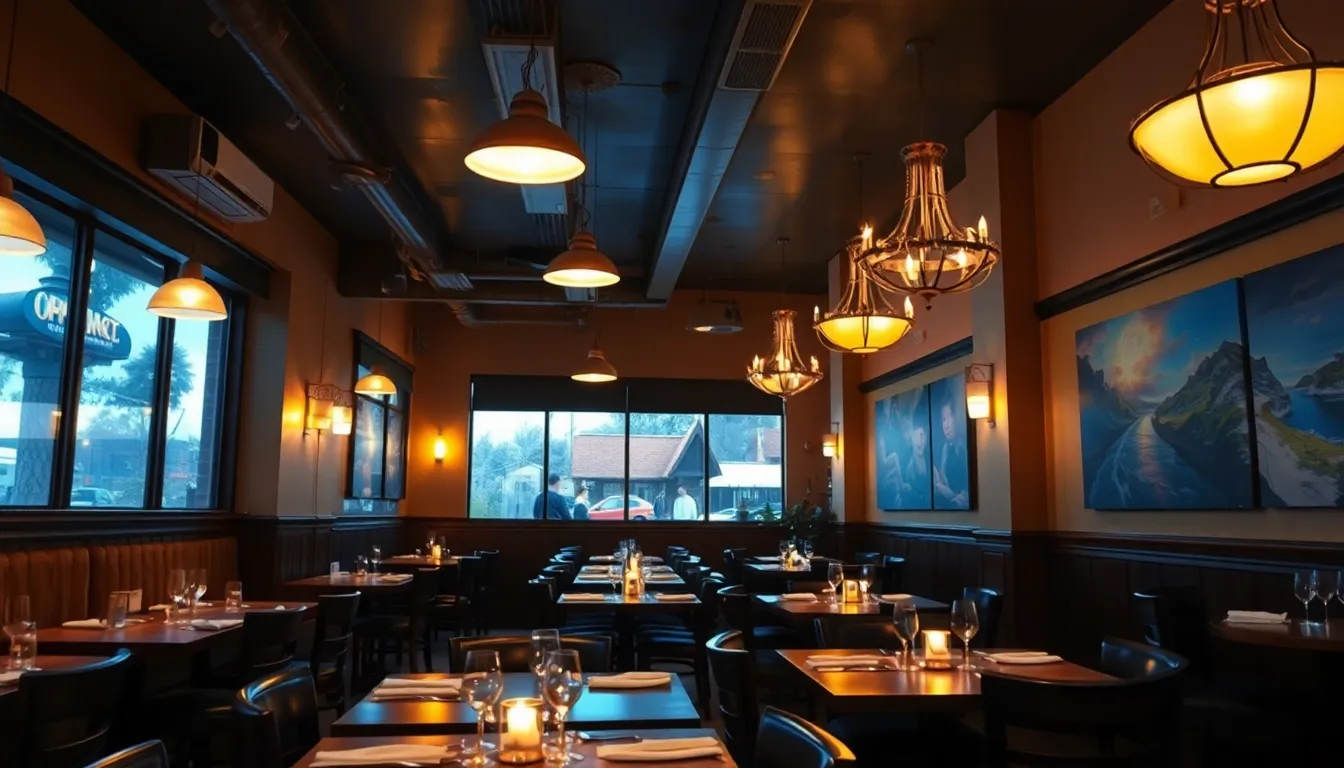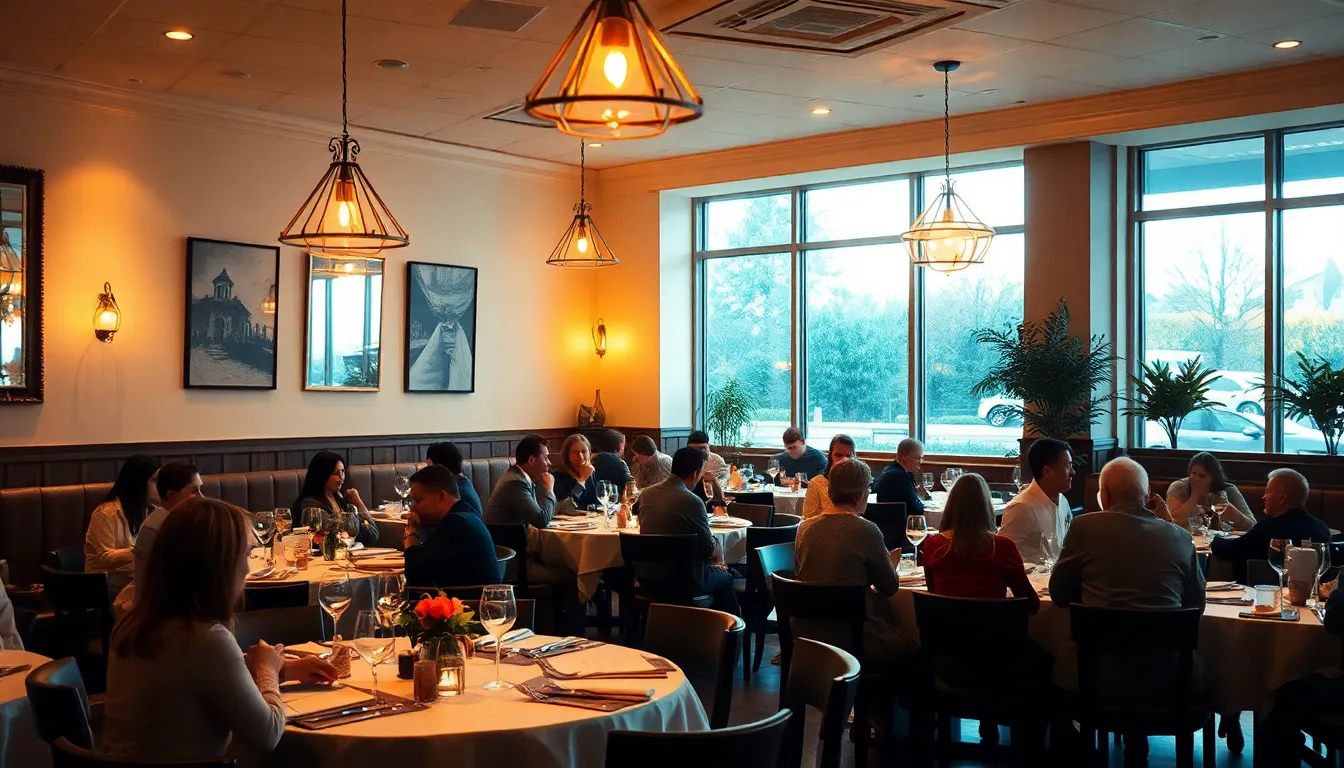When it comes to dining out, the food may steal the show, but let’s not forget the unsung hero of the experience: restaurant lighting. Imagine biting into a perfectly cooked steak only to realize you’re in a fluorescent-lit dungeon. Not exactly appetizing, right? The right lighting can transform a meal from ordinary to extraordinary, creating an ambiance that makes patrons linger over dessert instead of rushing to leave.
Table of Contents
ToggleImportance Of Restaurant Lighting
Restaurant lighting significantly influences the overall dining experience and ambiance. Well-planned lighting can invite guests to linger and enjoy their meals.
Creating Atmosphere
Creating a welcoming atmosphere relies on lighting choices. Soft, warm lights spread a cozy glow, encouraging patrons to relax. Dim lighting often evokes intimacy, making it ideal for romantic dinners. On the other hand, bright lights enhance energy in more casual dining spaces, promoting conversation and social interaction. Furthermore, unique fixtures contribute to a restaurant’s personality. An innovative lighting design can transform a space, setting it apart from competitors.
Enhancing Dining Experience
Enhancing the dining experience involves more than just functional lighting. Proper illumination highlights menu items, making dishes appear more appetizing. Guests appreciate the ability to see their food clearly while enjoying subtle, soothing background lighting. Dynamic lighting shifts can also align with the time of day or specific events, adjusting the mood as needed. Incorporating natural light into the design helps create a refreshing environment, increasing customer satisfaction. Thoughtful lighting choices lead to more enjoyable meals, resulting in positive reviews and repeat visits.
Types Of Restaurant Lighting

Different types of restaurant lighting play crucial roles in establishing ambiance and enhancing the dining experience. Each type serves a unique function, contributing to the overall atmosphere.
Ambient Lighting
Ambient lighting creates a soft, general illumination that fills the space. This lighting sets the foundation for the restaurant’s mood, providing comfort without overwhelming guests. Options include ceiling-mounted light fixtures, pendant lights, and chandeliers. By diffusing light evenly, the illumination fosters a relaxed environment conducive to conversation. Restaurants often use dimmable options to adjust brightness levels throughout the day. Warm tones are popular, as they evoke coziness and encourage patrons to linger over meals.
Task Lighting
Task lighting focuses on specific areas where additional light is needed for dining activities. This type enhances functionality while ensuring a pleasant experience. Examples of task lighting include sconces above tables or pendant lights over countertops. These fixtures facilitate reading menus and enjoying food clearly without straining. Strategic placement helps illuminate food preparation areas, ensuring that chefs and staff complete tasks efficiently. It also contributes to safety, reducing the risk of spills or accidents in busy dining environments.
Accent Lighting
Accent lighting highlights specific features within a restaurant, adding visual interest and depth. This type brings attention to artwork, architectural elements, or beautifully presented dishes. Track lighting and spotlights are common fixtures used to create layered illumination. By contrasting with ambient lighting, accent lighting establishes focal points that guide the eye and shape the overall aesthetic. Effective use of this lighting adds sophistication and character, enhancing the uniqueness of the dining experience. Careful selection and placement ensure that the ambiance remains inviting rather than harsh.
Strategies For Effective Restaurant Lighting
Effective restaurant lighting involves intentional strategies that enhance the dining ambiance while catering to the clientele’s needs. Thoughtful design choices maximize comfort and promote a unique atmosphere.
Choosing The Right Fixtures
Selecting appropriate fixtures plays a vital role in setting the mood. Pendant lights, chandeliers, and wall sconces each add character and detail. Using dimmable options enhances versatility, allowing adjustments for different dining periods. Moreover, unique fixtures can become focal points, drawing attention and creating conversation starters. Consider functionality alongside design; task lighting ensures clarity in specific areas, such as over tables or kitchen prep zones. Aligning fixture styles with the restaurant’s theme further solidifies its identity.
Adjusting Light Levels
Adjusting light levels provides flexibility throughout the day. Morning service may require brighter lighting to energize patrons, while evening dining benefits from softer, more intimate illumination. Implementing a layered lighting approach fosters visual interest, mixing ambient, task, and accent lighting effectively. Smart lighting systems enable quick adjustments in response to changing moods or events, enhancing overall guest experiences. Regular assessment of lighting effectiveness helps maintain the desired ambience, ensuring customer satisfaction remains a top priority.
Common Mistakes In Restaurant Lighting
Ineffective lighting leads to uninviting atmospheres. Many restaurants overlook the significance of layered lighting, which combines ambient, task, and accent types. Failing to assess light levels throughout the day causes discomfort for patrons during meals. Bright lighting too late in the evening can disrupt relaxation, while dim lighting during busy hours makes it difficult to navigate the space.
Another common error involves using harsh fluorescent bulbs. These lights create a harsh environment, driving away customers seeking a cozy dining experience. Lack of focal points in the design diminishes visual interest, making the space feel flat and uninspired. Inadequate emphasis on menu items can lead to less appealing presentations, ultimately affecting orders.
Ignoring the importance of natural light also poses a mistake. Natural light enhances the ambiance and elevates meal enjoyment. Not utilizing dimmable fixtures limits flexibility, preventing easy adjustments throughout the day. Many establishments miss the opportunity to create an inviting environment with unique fixtures, which distinguishes them from competitors.
Poor color temperature selection impacts perception as well. Warm lights foster a cozy feel, whereas overly cool lights can create a sterile atmosphere. Emphasizing the dining experience often gets sidelined by focusing solely on functionality, sacrificing the overall aesthetic. Finally, failing to update lighting technology, such as smart systems, can lead to inefficiencies in energy consumption.
Restaurants benefit from avoiding these common pitfalls by prioritizing thoughtful lighting designs. Understanding the customer experience enables the creation of an inviting and memorable atmosphere.
Effective restaurant lighting is essential for creating an inviting and memorable dining experience. By carefully selecting lighting types and fixtures, establishments can craft an atmosphere that encourages guests to relax and enjoy their meals.
Attention to detail in lighting design not only enhances the visual appeal of the space but also highlights menu items in an appetizing way. A layered approach allows for versatility throughout the day, ensuring that the ambiance aligns with the dining experience being offered.
Avoiding common pitfalls in lighting design can make all the difference in customer satisfaction and retention. Ultimately, the right lighting transforms a simple meal into a delightful occasion that patrons will want to revisit.







